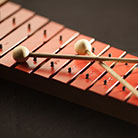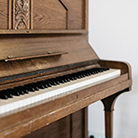Any device that produces a sound upon getting hit, shaken or scraped falls into this category. Many devices belong to this family owing to this working. However, becoming a percussionist is not as easy as it sounds, and it takes a lot of time and practice. You need to master when to hit the device, how much force you should use and the exact place where you should strike. Issues such as tuning are also crucial in learning how to produce great music.
The impressive thing about percussionists is that they handle more than one device at a time. They could be playing the bass drum in one moment and the next, they are handling cymbals. Having these devices in a number adds to the variation of sounds and thus creates excitement in the atmosphere. When classifying these devices, people often name the piano as the key with the others such as the chimes, timpanis, celestas, gongs, and tambourines falling under the grouping of other percussion musical devices. Have a look:
Xylophone

Studies trace the origin of this musical device to Asian and Africa. The interesting thing though is that it has a Greek name which refers to a sound made from wood. To handle this device, you need to strike the keys with a mallet. You can alter the notes by alternating between a soft and a hard mallet.
The Piano

This device is one of the most significant musical devices of all time. There is a debate as to whether it should belong to the percussion or the string family. You see, to play it, you will need to strike its keys, and this makes it fall into the percussion classification. However, once you strike the keys, they in turn lift hammers which hit the strings which create sound, and this makes some people argue that the piano is indeed a stringed musical device. There is also the fact that pianos have way more strings than any of the devices in the stringed family. In this case, the grouping is up to one’s opinion, and you can choose to classify it in either of the families.
One thing that people appreciate regarding this musical device is how broad its range is. With it, you can play about with notes, even playing more than one at once. It can play both the melody and harmony or can be part of an ensemble where it can support the latter. There is no denying that it indeed is a wonder and a blessing to any orchestra.
The Timpani
This device, also known as the kettledrum, features copper pots covered with plastic or calfskin. The great thing about them is that you can tune them by altering the fit of the covering, allowing you to hit different notes as you play. To play this device, you need to have a great ear for pitch as you will handle about four of these devices in an ensemble.
The Bass Drum
This device results in low sounds owing to its vast size. It works similarly to kettledrums and is excellent when you want to produce different sounds.
Snare Drum
This drum can be of brass or wood, and as is the case with the kettledrum, the covering could be plastic or calfskin. Wire-wrapped strings cover its snare, and they result in a rattling sound when you strike the drum. You can alter the rattling depending on the kind of music you want to play.
Cymbals
If you want to make, your number stand out, have this device in play. It comprises a metal disc which you strike to create sound. To get a low tone, you should opt for a big disc. If you want a high-pitched sound, then a small cymbal will do the trick.
Triangle
This metallic device is probably one of the most straightforward percussion devices to master. As the name suggests, it comes in a triangular form. You suspend it on a string and then strike it with a metallic beater to create sounds. You can vary the notes based on the size as well as the thickness of the beater.
Other devices in the percussion family include the tambourine, maracas, the gong, chimes, castanets, and the celesta. What’s your pick?



